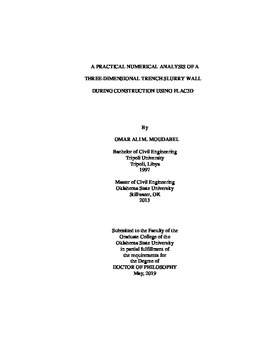| dc.contributor.advisor | Bulut, Rifat | |
| dc.contributor.author | Moudabel, Omar Ali M. | |
| dc.date.accessioned | 2019-10-25T19:51:39Z | |
| dc.date.available | 2019-10-25T19:51:39Z | |
| dc.date.issued | 2019-05-01 | |
| dc.identifier.uri | https://hdl.handle.net/11244/321559 | |
| dc.description.abstract | A soil-bentonite cutoff wall is constructed by excavating a trench with a backfill mix of soil, bentonite, and water. The trench will be a vertical barrier to support the ground movement during construction and permanent barrier. It is constructed panel by panel causing changes on stresses of the soil. These considerable changes in stress cause substantial ground movement. Despite the fact that soil-bentonite cutoff slurry walls are common, their mechanical behavior is not always well understood. There is a greater need to understand the behavior of the soil during the construction to avoid damages to near structures. Current studies do not consider the final stress state of the soil-bentonite backfill or deformations in the adjacent ground for multiple soil layers. A three-dimensional Lagrangian base numerical method was used to model the mechanical responses of the ground for Lake Tyler Dam. The ground response including horizontal normal stresses, shear stresses, lateral ground displacement, and vertical ground surface settlement was analyzed during the slurry excavation for each diaphragm wall panels. Numerical results show that slurry trenching leads to horizontal stress relief of ground and shear stresses in the panel elements. However, there are some magnitude differences of these reliefs caused by each layer. The large magnitude of lateral ground displacement and vertical ground surface settlement were found in the excavation of some panels at the upper part of the trench. The backfill of the wall should consider the need to compensate partially the horizontal stress loss and reduces the lateral displacement as well as the vertical settlement of ground. This finding implies the necessity of protecting the upper part of the trench in a certain stage of excavating individual wall panels. There is a non-uniform horizontal stress distribution behind the panel, the stress being the smallest at the center but increasing in magnitude toward the corner and decreasing beyond the panel. This needs more attention during the excavation of each panel with the consideration of each layer of material properties. | |
| dc.format | application/pdf | |
| dc.language | en_US | |
| dc.rights | Copyright is held by the author who has granted the Oklahoma State University Library the non-exclusive right to share this material in its institutional repository. Contact Digital Library Services at lib-dls@okstate.edu or 405-744-9161 for the permission policy on the use, reproduction or distribution of this material. | |
| dc.title | Practical Numerical Analysis of a Three-Dimensional Trench Slurry Wall During Construction Using FLAC^3D | |
| dc.contributor.committeeMember | Samir Ahmed, Mohamed | |
| dc.contributor.committeeMember | Soliman, Mohamed | |
| dc.contributor.committeeMember | San, Omer | |
| osu.filename | Moudabel_okstate_0664D_16267.pdf | |
| osu.accesstype | Open Access | |
| dc.type.genre | Dissertation | |
| dc.type.material | Text | |
| dc.subject.keywords | flac3d | |
| dc.subject.keywords | numerical analysis | |
| dc.subject.keywords | slurry wall | |
| dc.subject.keywords | soil-bentonite cutoff wall | |
| dc.subject.keywords | stability analyses | |
| thesis.degree.discipline | Civil Engineering | |
| thesis.degree.grantor | Oklahoma State University | |
